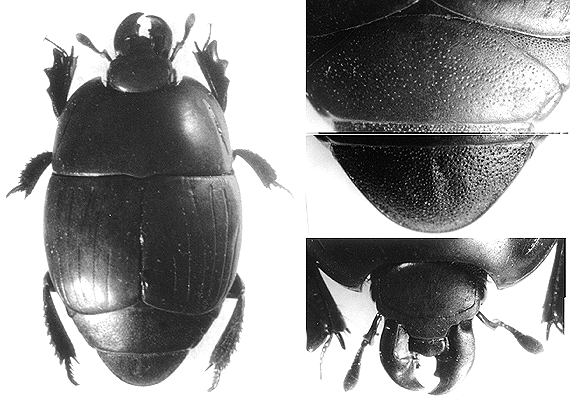
Hister chinensis Quensel in Schonherr, 1806, 88.
Hister (Pachylister) chinensis: Bickhardt, 1913, 171 [Taihorin, Kankau (Kôshun), Tainan, Anping, Sokutsu (Banshoryo-distr.)].
Pachylister chinensis: Lewis, 1904, 146; 1915, 55 [Horisha]; Miwa, 1931, 56 [Horisha]; Kato, 1933, pl. 49, no. 2; Kamiya and Takagi, 1938, 29; ESK & KSAE, 1994, 137 [Korea]; Ohara, 1999, 106.
Pachylister (Pachylister) chinensis: Mazur, 1997, 105.
Japanese name: Taiwan-o-emmamushi.
Redescription. (Ohara, 1999a).
Body oval, convex, black and shiny except elytra; tibiae reddish brown. Biometric data are given in Table 2.
Frontal stria of head (Fig. 19B, 20A) distinctly impressed and finely crenate laterally, the middle of anterior portion weakly impressed, sometimes interrupted. Head covered with rugulose microsculpture. Mandibles well developed, with two large denticles on inner side. Anterior margin of labrum angulated outwardly at middle (Fig. 20A).
Pronotal sides (Fig. 19A, 20B) regularly arcuate and convergent apically. Apical angle obtusely angulate. Marginal pronotal stria complete laterally and broadly absent on anterior portion. Outer lateral pronotal stria impressed on apical half. Inner lateral stria deeply impressed and abbreviated on apical and basal one-sixth. Disk of pronotum covered with coriaceous microsculpture. Posterior margin of pronotum strongly sinuate and obtusely angulated posteriorly at middle. Antiscutellar area of disk with a longitudinal punctures.
Epipleural marginal stria complete and distinctly carinate
ventrally; elytral marginal stria absent; disk of epipleura deeply
excavated on posterior half. External subhumeral stria (Fig. 20B)
present on posterior half. Oblique humeral stria lightly impressed
on basal half. First to third dorsal striae deeply impressed,
crenulate and complete; fourth dorsal stria abbreviated on one-eight
to one-third; fifth stria rudimentarily presented on apical third.
Surface of elytra clothed with coriaceous sculpture.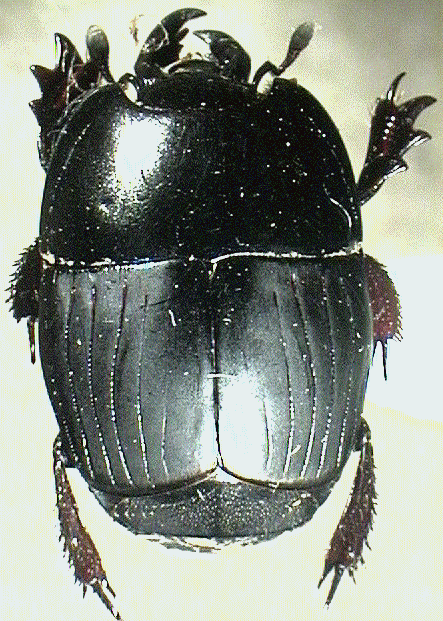
Propygidium (Fig. 19C) irregularly covered with coarse and fine punctures, the punctures separated by 110 times their diameter; disk wholly clothed with strigose ground microsculpture. Pygidium (Fig. 19D) densely and coarsely punctate, the punctures separated by 0.54 times their diameter; disk clothed with strigose ground microsculpture; posterior margin elevated.
Anterior margin of prosternal lobe (Fig. 20C) regularly round; marginal stria clearly and completely impressed and carinate; disk evenly covered with coarse punctures that are separated by 23 times their diameter and become sparser on middle. Prosternal keel narrow and without carinal stria; disk densely covered with coarse and large punctures on lateral area and a few punctures on top of keel. Lateral stria deeply impressed and carinate.
Anterior margin of mesosternum (Fig. 20C) strongly emarginate at middle; marginal stria well impressed, carinate and interrupted medio-laterally; another short stria present behind each anterior angle; disk covered with alutaceous sculptures. Meso-metasternal suture lightly impressed and angulated at middle. Post-mesocoxal stria of metasternum extending along posterior margin of mesocoxa, and becoming distant from the margin, the outer end attaining at outer angle of metasternum; lateral metasternal stria clearly impressed and strongly carinate, obliquely extended posteriorly, and united with oblique stria that is carinate and inwardly extends from the middle of metasternal-metepisternal suture; sculptures of intercoxal disk similar to that of mesosternum; anterolateral disk densely covered with deep, large and setiferous punctures, the punctures becoming finer and sparser inwardly: posterolateral disk densely and coarsely punctate.
Intercoxal disk of first abdominal sternum with sculpture similar to that of the intercoxal disk of mesosternum; lateral stria deeply impressed, sinuate and shortened on basal third.
Protibia (Fig. 20D, E) with 3 large denticles on outer margin, the apicalmost denticle with 2 spines. Meso- and metatibiae with 2 rows, each consisting of 10-13 stout spines. Profemoral stria complete and strongly carinate.
Male genitalia as shown in Fig. 21. Aedeagus of male genitalia slender; basal piece small; ratio in length of paramera to basal piece about 3.9.
Specimens examined.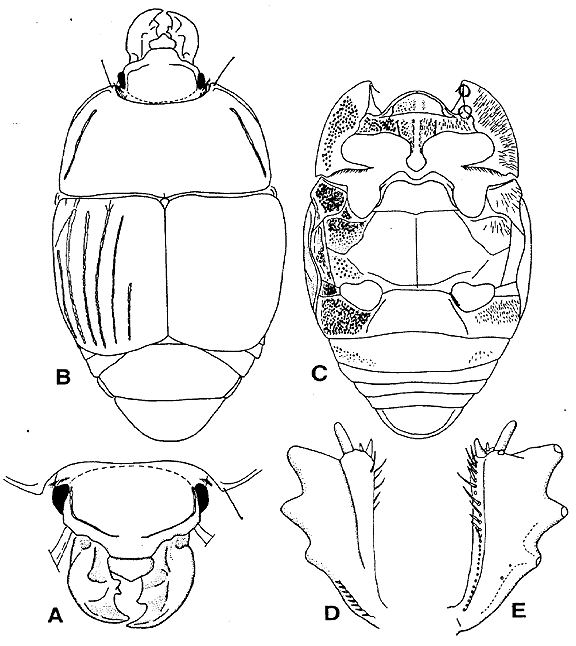
[Nansei Isles] Ishigaki Is.: Sakieda (2 exs., 28/x/1994, collected from cow dung), S. Hori; Tomino (32 exs., 26/iii/1994, collected from cow dung), K. Toyoda; Omoto (2 exs., 26/iii/1994, collected from cow dung), K. Toyoda. Iriomote Is.: Toyoura (2 exs., 20/iii/1998, collected form cow dung), M. Maruyama; Funaura (1 ex., 19/iii/1998, collected from cow dung), M. Maruyama.
Remarks. This species is common in Taiwan. As it had not been recorded from south-western Japan until 1994, the species may have been introduced fromTaiwan. It is now common under cow dung in Ishigaki and Iriomote Iss., Japan.
This species can easily be distinguished from all Japanese
members of the tribe Histerini, in addition to the character on
the labrum, by the following combination of character-states:
large body size, strongly developed mandibles, absence of anterior
portion of marginal and lateral pronotal striae, and elytra covered
with frosty microsculpture.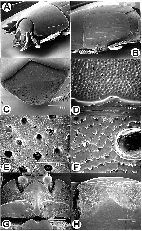
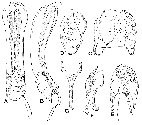
Female genitalia as shown in Fig. 27. Spermatheca consisting
of 6 small sacs and attached to the dorsal wall of vagina, the
wall strongly extruded apically. Bursa copulatrix sclerotized.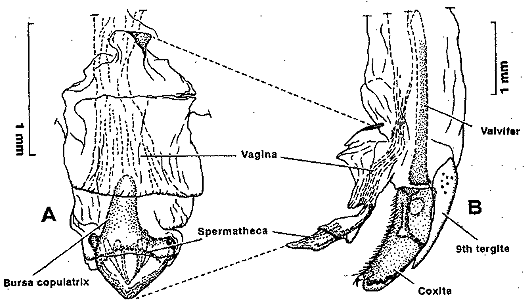
Specimens examined.
Taiwan. [Proper] Taipei Hsien: Pali (6 exs., 12/ii/1997), Y.Y. Lien; Ilan Hsien: Chenshantsun (1 ex., 18/x/1976), M. Kiuchi. Hsinchu Hsien: Hukou (2 exs., 24/x/1971), K. Masumoto. Miaoli Hsien: Penglai (= Kotsubo) (1 ex., 16/vii/1968), H. Makihara. Taichung Hsien: Eastern cost line, Tuli (3/iv/1994), Y.Y. Lien. Nantou Hsien: Nanshanchi (2 exs., 2/x/1984), S. Osawa; (1 ex, 5/viii; 13 exs., viii/1972; 2 exs., 10/vi; 1 ex., 26/vi/1973), Q. Du; (1 ex., 28/vii/1974), K. Masumoto; (1 ex., 2/viii/1976), K. Tazoe; (11 exs., 30/iii/1977), W. Suzuki; Yushin river (1 ex., 11/xi/1986), H. Tanaka; Piilu (2 exs., 22/x/1971), K. Masumoto. Tainan Hsien: Koupi (= Houpi, Kouheki) (6 exs., 8/xi/1976), M. Kiuchi. Kaoshiung Hsien: Near Liukuei (1 ex., 10/vii/1989), C.W. Chen; Liukuei (4 exs., 30/iv; 7 exs., 1/v; 1 ex., 37/v/1986), M. Ohara; (12 exs., 6/iv/1987), K. Baba. Pingtung Hsien: Hengchun (= Koshun) (1 ex., 15/vii/no year), Mogi; Kenting (1 ex., 16/ix; 4 exs., 3/xi; 1 ex., 9/xi/1986; 3 exs., 5/v/1987), H. Tanaka; (1 ex., 16/viii/1968), K. Y.; Kenting Natural Park (3 exs., 26/xi/1990), S. Osawa; (1 ex., 3/vi/1974), Y. Miyake; Shenting Park, Kenting National Park, Henchun (2 exs., 16/ii/1994; 1 ex., 9/ii/1995; 1ex., 10/ix/1996), Y.Y. Lien; Sizhonchi (4 exs., 11/v/1986), M. Ohara. Hualien Hsien: Taroko (2 exs., 20/x/1976), M. Kiuchi; Hsinsheng (2 exs., 1011/xi/1994, 25/ix/1995), Y.Y. Lien. ?: Taiwan Botanical Garden (2 exs., 2/viii/1968), T. Kusaka.
[Lanyu Is.] (5 exs., 1822/iv/1986), M. Ohara; (2 exs., 9/iv/1978), K. Murakami.
Remarks. This species usually occurs in fresh cow dung.